Free Online Productivity Tools
i2Speak
i2Symbol
i2OCR
iTex2Img
iWeb2Print
iWeb2Shot
i2Type
iPdf2Split
iPdf2Merge
i2Bopomofo
i2Arabic
i2Style
i2Image
i2PDF
iLatex2Rtf
Sci2ools
CHI
2001
ACM
2001
ACM
Classroom collaboration in the design of tangible interfaces for storytelling
We describe the design of tangible interfaces to the KidPad collaborative drawing tool. Our aims are to support the reenactment of stories to audiences, and integration within real classroom environments. A six-month iterative design process, working with children and teachers in school, has produced the "magic carpet", an interface that uses pressure mats and video-tracked and barcoded physical props to navigate a story in KidPad. Reflecting on this process, we propose four guidelines for the design of tangible interfaces for the classroom. (1) Use physical size and physical props to encourage collaboration. (2) Be aware of how different interfaces emphasize different actions. (3) Be aware that superficial changes to the design can produce very different physical interactions. (4) Focus on open low-tech technologies rather than (over) polished products. Keywords Tangibles, children, storytelling, participatory design
CHI 2001 | Human Computer Interaction | Physical Props | Six-month Iterative Design | Tangible Interfaces |
| Added | 01 Dec 2009 |
| Updated | 01 Dec 2009 |
| Type | Conference |
| Year | 2001 |
| Where | CHI |
| Authors | Danae Stanton, Victor Bayon, Helen Neale, Ahmed Ghali, Steve Benford, Sue Cobb, Rob Ingram, John R. Wilson, Tony P. Pridmore, Claire O'Malley |
Comments (0)

